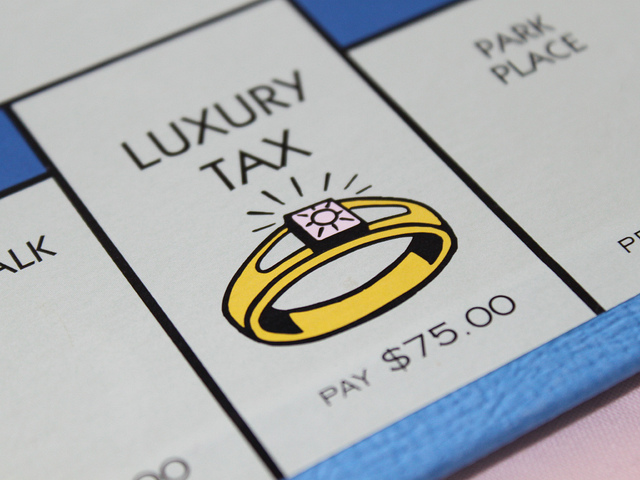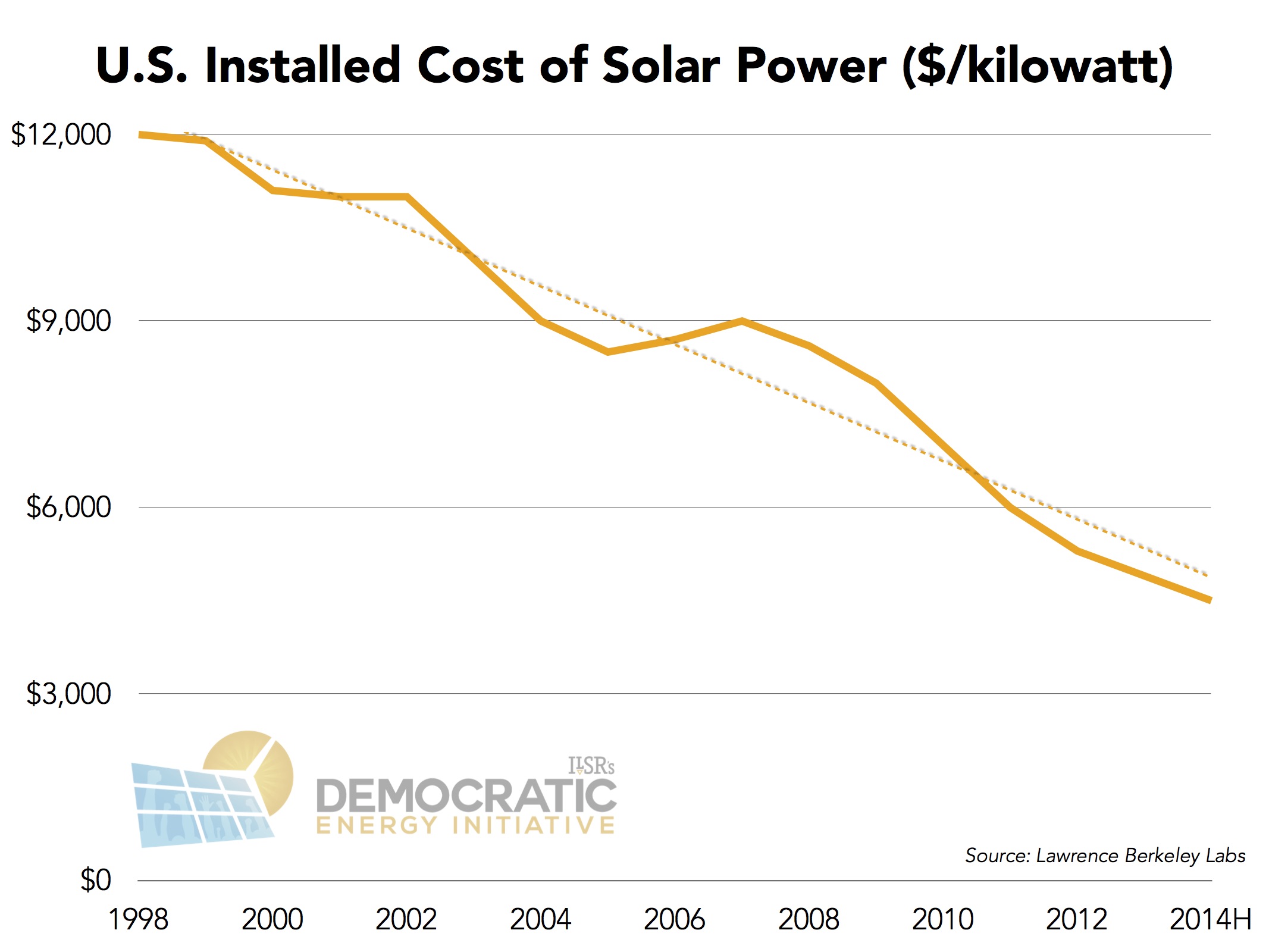This week in democratic energy, community solar projects are predicted to rule 2015 and net metering policies are opening the market for a brighter future.
Jeff St. John started us off with why he thinks 2014 could be dubbed the year of the “smart grid.”
From building on the prior wave of investment in AMI networks [advanced metering infrastructure] and grid intelligence, to bridging the gaps between utilities and their customers, and laying the groundwork for a marriage of distributed energy and utility operations, 2014 saw some key developments that help indicate where the industry must go from here, if it’s to grow.
We’re with him, and would like to see it go much farther than “2.0.” Check our our Democratic Energy Report for the dawning of Utility 3.0!
The Motley Fool’s Justin Loiseau made an interesting connection between NY Governor Cuomo’s move to ban fracking and his $1 billion solar commitment.
“The state made its decision based on public health threats outlined in a seminal 184-page Department of Health report, but it did so at the expense of around 141 trillion cubic feet of untapped natural gas — equivalent to 128 times the state’s current annual consumption.
New York has bid farewell to fracking, and its support for solar will shape its energy future for decades to come.”
CNBC’s Brad Quick reports that New York City is embracing solar investments, and other New York communities are getting on board as well. Heather Leibowitz and Kevin Parker praised a public library solar installation in Brentwood, and William Kremble with the Freeman Online reports that Woodstock’s town board and Kingston, nearby are both looking at solar energy options– Woodstock could start a municipal initiative to buy solar panels, Kingston is looking at installing panels on the school roof.
Tonya Maxwell with Greenville News in South Carolina reported this week on the double whammy that residential solar owners are seeing. They get to be environmentally conscious, but also they are saving about 80% on their power bill.
“It was the tree hugger in us that looked into solar. It was the economics that had us looking at what best ways would could recoup our costs,” said the mother of two. “It was a financial decision that made sense.”
Not to be outdone, Massachusetts is making a name for itself in the solar arena. Ann O’Connor thought of a nice way to visualize the solar boom:
For every seat in Fenway Park, there are 47 solar panels in Massachusetts. There are also 346 solar companies employing 8,400 people throughout the state, doing everything from making parts to installing systems… Those shiny panels on rooftops are becoming commonplace.
And Stephanie Shor’s report on Kake, Alaska’s alternative energy investment shows how a cooperative model can work for some communities:
Adam Davis, community and economic development specialist for the Organized Village of Kake, said the system on the government building has produced 11,985 kilowatts so far, with an estimated fuel savings of $7,550…
He [also] said the school had an $110,000 surplus in its budget last year, and he has plans to propose switching the school to LED lights. This would reduce the building’s electricity usage by 60 percent, and the savings would pay for another full-time teaching position.”
Back in the Midwest, another cooperative energized its newest solar project. LaReesa Sandretsky with the Lake County News Chronicle covered the story:
“We are happy to have this solar project installed in our service territory,” said Steve Wattnem, CEO of Cooperative Light & Power. “Our members will benefit from the solar output as we, along with Great River Energy, learn about the performance of solar with this local project.”
In addition to the Two Harbor’s solar site, Great River Energy is working with 18 other member cooperatives throughout the state to construct similar solar arrays.
Still, some states are lagging behind in solar energy because of restrictive policies, and residents are taking notice. Nick Hylla kicked off 2015 with a plea to Wisconsin lawmakers, and others should take note as well: Stop Pushing Wisconsin’s Energy Policy Backward!
“The public is frustrated with the coordinated, special-interest efforts to slow public and private investments in clean energy. The rate cases in Wisconsin demonstrate an especially alarming trend: the alignment of the manufacturing lobby behind the monopoly utilities’ rate “fairness” campaign.
The investors in these industries stand to garner significant returns as “pay for use” electricity markets are transformed into “pay for access” (like paying more to park in front of the gas pump than for the fuel itself). With increasing meter fees and decreasing use rates, utilities fix their profits and build financial incentives for increased energy use. Large energy users benefit as costs shift to the many meters attached to homes, businesses and municipalities.
The losers in this new regime are the thousands of homes and businesses that have made efficiency investments, taken conservation measures, and/or installed their own renewable energy system (not to mention all of the businesses that serve them). The new utility strategy will also cause significant collateral damage to those in low and fixed income households who simply can’t afford large increases in fixed energy costs.”
In Michigan, a torn-down coal plant may make way for green energy. Stephen Kloosterman with MichiganLive highlighted the historic changes ahead for utility companies and energy customers.
Three Mississippi Counties will be testing out the power of solar. Jeff Ayres with the Clarion-Ledger reported this week that the state’s Public Service Commission is piloting a $4.3 million study to determine if solar is a viable option for electricity production.
Some Hawaii lawmakers are getting nervous about who bought their state’s largest utility. Florida Power & Light recently purchased Hawaiian Electric Industries. Doreen Hemlock with the Sun Sentinal:
“Florida is not known for rooftop solar. It’s known for utility-scale projects,” Leslie Cole-Brooks, executive director of the Hawaii Solar Energy Association, told a Hawaii TV station. “And here in Hawaii, the Hawaii Solar Energy Association is all for maximizing all of our resources.”
U.S. Sen. Mazie Hirono, a Democrat from Hawaii, has said she hopes FPL’s parent comes to her state with a “different attitude” on rooftop solar, adding that the purchase “deserves careful scrutiny.”
Ivan Penn with the Tampa Bay Times echoed that concern, and noted the difficulties Florida residents often have when trying to change energy policy.
As it stands, rooftop solar threatens the traditional utility business model. Homes and businesses would use less power from the utilities, decreasing their revenue — something the industry fears.
At a time when the utilities are expressing concern about the impact of solar, state regulators voted in November to gut energy-efficiency goals and to end solar rebates administered by the utilities, saying they are not “cost-effective.”
From the “for-once-and-for-all-can-this-debate-finally-be-resolved” file: John Moore with Sustainable FERC Project in Chicago writes:
Despite years of successful experience, dozens of studies, and increasing utility support for clean energy, urban myth holds that electricity from renewable energy is unreliable. Yet over 75,000 megawatts (MW) of wind and solar power have been integrated, reliably, into the nation’s electric grid to date. That’s enough electricity to supply 17.9 million homes.
Maybe this video will help? Even on the shortest day of the year, solar can power our cars and homes:
Happy 2014!




